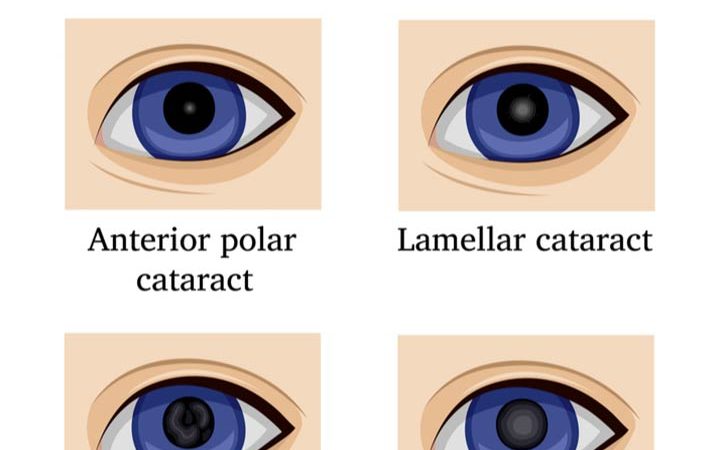Congenital cataract is an eye condition prevalent among newborns. In this infantile disease, the baby’s natural eye lenses appear milky white from birth. Congenital cataract is different from other cataract forms. The former is mostly inherited and present at birth, while the latter develops at an older age.
Congenital cataracts are important to address as they hamper the development of nerves that connect the eyes to the brain. The white cloudiness of the lens obstructs natural vision and may lead to permanent vision loss if left untreated.
Read this post to know about the types, causes, symptoms, diagnosis, and treatment of congenital cataracts.
What Are Congenital Cataracts?
In a healthy eye, the lens remains clear, while in congenital cataracts, the transparency of the eye lens is hampered at birth (1). It is also possible to acquire cataracts after childbirth; in this case, they are known as infantile cataracts or juvenile cataracts.
The transparency and refractive index of a healthy lens are maintained by a family of proteins present in the eye lens (2). However, the natural proteins inside the eye lens tend to form clumps or protein aggregates during cataract formation. These clumps of protein are large particles that appear cloudy. In this way, a cloudy opacification of the eye lens occurs in a cataract, which sometimes results in vision loss.
What Are The Types Of Congenital Cataracts?
The common types of congenital cataracts are (3)):
- Anterior polar cataracts: Opacity develops at the front of the eye lens. A distinguishable spot is visible in the middle of the pupil. They are usually small and do not require surgery. They are usually managed by using corrective lenses. A larger size may need surgical intervention.
- Posterior polar cataracts: Opacity develops at the back of the eye lens near the optical center. Posterior polar cataracts have a large impact on visibility.
- Nuclear cataracts: Opacity develops at the central part of the lens. It is the most common form of congenital cataract.
- Cerulean cataracts: Opacity develops as scattered bluish regions in the lens. It is a progressive form of congenital cataract. Infants have little or no symptoms, and the condition worsens over adulthood. It is usually associated with multiple genetic mutations.
What Are The Signs And Symptoms Of Congenital Cataract?
Clouding of intraocular lenses in newborns is the primary sign of congenital cataracts (4). These could be visible as cloudy patches in the eyes. Some of the other signs and symptoms of congenital cataracts are the following.
- The poor vision may result in a “wobbling eye” where the eyes point in different directions.
- The child may have involuntary and rhythmic eye movements.
- A white pupil, which is otherwise black, is a clear sign of underlying vision abnormalities.
- A missing “red-eye” glow in a photo with a flash.
- The baby may seem unaware or may not notice people and objects even in close proximity.
What Causes Congenital Cataracts?
According to the National Health Service (NHS), UK and the US National Library of Medicine, a child might acquire a congenital cataract due to the following reasons (1) (4) (5) (6) (7) (8).
- Heredity: The child may acquire the disease from their parents. Half of the congenital cataract cases involve dominant inheritable traits, which run in the families.
- Genetic mutations: Genes hold the information for proteins. Proteins are the workhorse for all biological processes. Therefore, a mutation in important proteins, such as alpha-crystallin, has a key role in the disease pathology.
- Chromosomal defects: Chromosomal anomalies, such as Down’s syndrome, could accompany congenital cataracts.
- Infections: Maternal infections during pregnancy, such as cytomegalovirus, herpes, rubella, and chickenpox, could increase the risk of congenital cataracts in babies.
- Medications: The use of tetracycline, corticosteroids, and vitamin A during pregnancy could cause congenital cataracts.
- Physical trauma: Injury to the child in the mother’s womb may lead to a congenital cataract.
- Hypoglycemia: Consistent low blood sugar levels during pregnancy might contribute to congenital cataracts.
What Happens If A Baby Has Congenital Cataracts?
A baby with a congenital cataract may have difficulty seeing through the affected eyes. It could lead to the following scenarios.
- Coordinated movement of eyes could be hampered.
- The normal vision development process is affected, and the baby is at risk of vision loss as they grow older.
- The condition may lead to permanent blindness in the absence of adequate treatment.
- The child may face difficulty in the physical, emotional, and social domain due to loss of sight.
Are Congenital Cataracts Associated With Other Problems?
Congenital cataracts can sometimes develop into permanent vision loss, a condition known as amblyopia or “lazy eye.” Amblyopia occurs at an early age. The affected eye does not get adequate visual stimulation for neural development. The lack of neural development often leads to permanent vision loss.
Congenital cataract surgery has a risk of complications such as glaucoma and retinal detachment (9) (10). Glaucoma is one of the associated post-surgery complications. In a retinal detachment, the retinal tissue underneath the eye tissue becomes detached. The retinal detachment can be fixed surgically.
Congenital cataracts are also often associated with other eye conditions such as strabismus and nystagmus (11). These are movement and alignment disorders of the eye and often lead to permanent vision loss if left untreated.
How Are Congenital Cataracts Diagnosed?
The diagnosis of congenital cataracts is performed through eye screening by a pediatric ophthalmologist (4).
- American Academy of Pediatrics recommends that an eye test, known as the “red reflex” test, should be performed to detect ocular pathology in neonates and children. A red reflex test is performed using an ophthalmoscope to determine the transparency of optical media in an eye. In a red reflex test, ocular abnormalities, such as dark spots or white reflexes, can be observed.
- Retinoscopy is performed to estimate the refractive index of an eye of a pre-verbal child. In addition, the extent of eye lens opacity can be determined using this technique. If the opacity exceeds 3mm, it is considered visually significant, and corrective measure is necessary.
- Laboratory tests, such as blood tests, could be suggested to determine the presence of other problems or rule them out.
A baby diagnosed with a congenital cataract should be treated under a specialist eye doctor. If surgery is required, it should be performed with urgency, as and when suggested by the doctor.
Some of the eye conditions, such as cerulean cataracts, may not need cataract surgery. An eye doctor may prescribe a corrective lens in specific cases. In such a case, routine clinical checks should be scheduled to ascertain the progress of cataracts.
How Are Congenital Cataracts Treated?
Mild congenital cataracts may not require any specific treatment, and corrective measures, such as the use of glasses, could help improve the baby’s vision. The baby will require regular follow-up to check vision quality.
Moderate to severe congenital cataracts that affect vision and could affect the baby’s development will require surgery (8). Generally, congenital cataract surgery is performed within a few weeks to three months from birth. The surgery is performed under general anesthesia.
Since the natural lens is lost during the cataract removal procedure, adding a corrective lens to the eye becomes important. Cataract removal surgery is generally followed by an intraocular lens (IOL) implantation procedure. The artificial lens gives corrective vision to the baby.
After surgery, a dark patch is usually advised to cover the normal eye for several hours a day. This is done for several years in order to help the operated eye gain normal vision. The doctor may also suggest contact lenses and glasses to further improve the baby’s vision. The baby will require regular check-ups to determine the functions of the intraocular lens and the vision’s quality. Surgery cures congenital cataracts in most babies.
How Can Parents Help?
Parents play a central role in the caregiving and treatment of congenital cataracts.
- If any sign of a milky white opacity is apparent inside the baby’s eye lens, parents should alert an ophthalmologist.
- Family history of any eye complication should be shared with the doctor. For example, you must share it with the doctor if the baby has a family member or sibling with a history of congenital cataracts.
- Babies may have other complications after congenital cataract surgery. Therefore, regular follow-up is important.
- Using a contact lens or spectacle requires the significant attention of parents. In addition, proper care and hygiene should be maintained in handling the lenses.
-
- Medications and eye drops should be applied as per the schedule.
Congenital cataract is a treatable eye condition. Early diagnosis of congenital cataracts is the key to avoid further eye complications. The management of the disease is complex and often requires the guidance of trained ophthalmologists. In addition, adequate care and regular check-ups are required over several months or years to gain normal vision. Always seek immediate medical attention if any abnormalities are observed in the baby’s eye.
References:
MomJunction’s articles are written after analyzing the research works of expert authors and institutions. Our references consist of resources established by authorities in their respective fields. You can learn more about the authenticity of the information we present in our editorial policy.



































